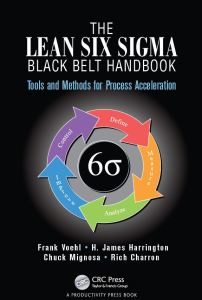Book Review: THE LEAN SIX SIGMA BLACK BELT HANDBOOK Tools and Methods for Process Acceleration, ISBN: 978-1-4665-5469-6
Published by CRC Press, this book was written by Frank Voehl, H. James Harrington, Chuck Mignosa, and Rich Charron. The Lean Six Sigma Black Belt Handbook is a detailed breakdown of the Lean Six Sigma methodology, its tools, and required processes. If you’re looking to run a Lean Six Sigma project, MSI strongly encourages you to consider picking up this book and using it as a roadmap to a successful project launch.
As you notice from the title, this book is designed to be a handbook. Something a Six Sigma Black Belt can carry with them and reference throughout the day as they lead a project. This book fills that role very nicely. One example is how every chapter starts with a “In a nutshell” section. The nutshell breaks down the important elements of the chapter in a way that is quick and easy to digest. Users of this book will certainly appreciate the fact they can quickly determine what to expect out of each chapter, considering how complicated Six Sigma can sometimes be.

Section one of this book starts by discussing an overview of Lean Six Sigma. Unfortunately, it starts by discussing a “growth path” for Six Sigma, specifically for Six Sigma certification. In particular it states: “The LSSBB methodology has been designed to provide a growth path for the people using it. The following outlines this growth path along with the prerequisites for each step in the path, starting at the beginning level.” If you’ve been following MSI over the years, you know we aren’t a fan of the belt “progression” thought-process. This isn’t necessary wrong, but it is not how MSI views belts. Instead, we encourage our members to think of the belts as job-functions, rather than a step-up progression in knowledge. Yes, Black Belts know more than Yellow Belts. Yes, Black Belts typically work as Yellow and Green belts before working as Black belts. That doesn’t necessary denote “progression” however, the role of a Black Belt is completely different than the role of a Yellow Belt. Regardless – this is a minor complaint and does not effect the overall quality of the book. Regardless of your certification level, most practitioners will start their careers as Yellow Belts and Green belts.
With that said, this book is very comprehensive by most standards. With over 500 pages of actual learning content, you’ll have all the information you’ll need at your fingertips. Whether you’re preparing for a certification exam, or leading a multi-faceted Six Sigma project, this book has you covered. With so much information, we’re only going to look at a few chapters that really stood out to us. Lets start by discussing Chapter 3. This chapter is all about waste identification. Every Lean Six Sigma book discusses waste, but this book dedicates an entire chapter to this subject. The authors describe the chapter like this: “Until recently, when we talk about learning to see waste, we are considering organizational wastes, not behavioral wastes. However, behavioral wastes can severely hinder Lean initiatives. This chapter describes what waste is and how to identify waste. It also discusses the mindsets that are the root causes of waste. These mindsets or belief systems are put into context here and described with terms like just-in-case logic. Almost all organizational wastes or process wastes are related to an employee in the organization that holds a traditional belief system. Learning to see variation (mura) or waste (muda) requires a shift in how we view our organization.” These are great points and something that every Lean Six Sigma practitioner should be aware of. As you would expect, variation (and charting it) is covered in detail in this section. Forget the standard 7 wastes, the authors identify 9 wastes you should be aware of – Overproduction, Excess inventory, Defects, Extra processing, Waiting, Motion, Transportation, Underutilized people. Employee behavior.
Where we feel this book really shines is Chapters 7 & 8, Black Belt Nonstatistical Tools. They cover so many important topics it needed to be spread out over multiple chapters. They dive into processes like 5S, then move on to benchmarking. These sections cover everything from Critical to Quality and Cycle Time Analysis and Reduction to Bureaucracy Elimination Methods and Conflict Resolution.
The book defines critical to quality as “Critical to quality (CTQ) is the analysis of the characteristics of a product or service that are critical to the customer or to the performance of the product or service to guarantee that they meet requirements.”, then goes on to say “Often a radar chart is used to identify critical to quality parameters/characteristics related to the item being evaluated. The importance to satisfying the customers’ requirements is rated on a scale of 1 to 10 for each of the legs of the radar chart. By connecting the points, you can readily see which parameters are critical to satisfying the customer.” and “A tree diagram is another approach used to define customer CTQs to determine process performance in relationship to voice of the customer (VOC)/voice of the business.“
One last note about this book that we rarely see, it includes a Six Sigma Body of Knowledge. This is a really good addition to the book because it lets us understand why the authors focused on specific topics more then others. They include a measuring system for each item in the BoK: “A” means they are almost always used, “O” means often used, “S” means sometimes used, “I” means infrequently used to never used. Quite a brilliant addition.
This book will help you prepare for the following certifications:
Six Sigma Black Belt certification
